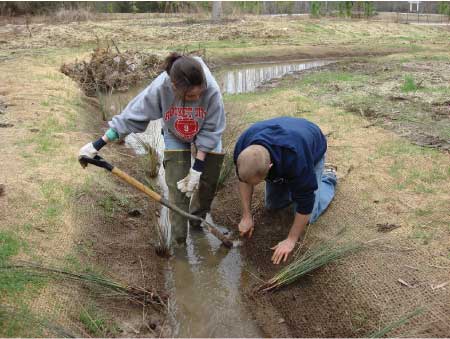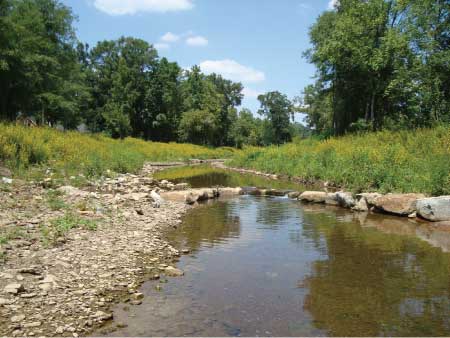- Alabama Agricultural Irrigation Information Network
- Alabama Natural Resources Council: Water Resources
- Alabama Water Watch
- ALEARN: Fisheries & Aquaculture Extension: Natural Resources
- Conservation & Rainwater Collection
- Drinking Water & Human Health
- Education & Outreach
- Environmental Restoration
- Nutrient & Pesticide Management
- Pollution Assessment & Prevention
- Wastewater & Wastewater Management
- Water Conservation & Management
- Water Policy & Economics
- Water Resources Publications
- Watershed Planning
- Workshop & Training Opportunities
- Water Resources Home
Environmental Restoration in Alabama
Background:
Although natural events such as fires, floods, earthquakes and volcanic eruptions cause significant changes throughout our environment, we generally think of environmental degradation as any unfavorable alteration of our surroundings caused by the activities of people. As our industrialization and population have increased, so has our capacity to damage the air, land, water and biological resources around us-the very resources we must maintain to sustain ourselves. Our environmental ignorance coupled with poor handling, management and disposal of potential environmental pollutants generated through the exploration, development and use of both natural and human-produced resources has resulted in widespread environmental degradation. Like most states, Alabama has its share of degraded ecosystems due to both intentional and non-intentional release of pollutants, which now reside in our land and water resources.
 Environmental restoration may be defined as the process of bringing an altered environmental area-whether it be a river corridor or stream segment, wetland area, industrial site, mined area, or a specific watershed-back to a previous condition or position. The process may involve a wide variety of treatment practices that minimize future pollution damage to air, land, water, and/or aquatic and land-based biological resources. Environmental restoration may also extend to physical removal of pollutants from a degraded site or in-situ reduction of pollutant concentrations through physical, chemical or biological processes. Remediation and reclamation are somewhat synonymous with restoration, but remediation usually deals with fixing a specific problem and reclamation often refers to environmental modifications to suit a particular land use, which may have been limited because of natural conditions such as drought. The U.S. Bureau of Reclamation, for example, was created for the specific purpose of reclaiming arid lands of the Western United States for agricultural cultivation and settlement.
Environmental restoration may be defined as the process of bringing an altered environmental area-whether it be a river corridor or stream segment, wetland area, industrial site, mined area, or a specific watershed-back to a previous condition or position. The process may involve a wide variety of treatment practices that minimize future pollution damage to air, land, water, and/or aquatic and land-based biological resources. Environmental restoration may also extend to physical removal of pollutants from a degraded site or in-situ reduction of pollutant concentrations through physical, chemical or biological processes. Remediation and reclamation are somewhat synonymous with restoration, but remediation usually deals with fixing a specific problem and reclamation often refers to environmental modifications to suit a particular land use, which may have been limited because of natural conditions such as drought. The U.S. Bureau of Reclamation, for example, was created for the specific purpose of reclaiming arid lands of the Western United States for agricultural cultivation and settlement.
Environmental Restoration in Your Watershed:
 Everyone who resides or works on the land surface of the earth does so within the boundary of a watershed. This watershed may be part of a bigger and bigger watershed as you go further downstream. Many land-based human activities have potential to degrade water resources. Degradation on a watershed basis can be determined by monitoring the quality of water draining from the mouth of the watershed and comparing it to similar watersheds that have not been impacted by disturbances or pollutants.
Everyone who resides or works on the land surface of the earth does so within the boundary of a watershed. This watershed may be part of a bigger and bigger watershed as you go further downstream. Many land-based human activities have potential to degrade water resources. Degradation on a watershed basis can be determined by monitoring the quality of water draining from the mouth of the watershed and comparing it to similar watersheds that have not been impacted by disturbances or pollutants.
To determine if restoration is needed in your watershed to improve water quality, you need to know how severely the water resources are being impacted by pollution. Much information is available from federal, state and local agencies as well as from other organizations and institutions to help you make this determination. Through a water-monitoring program and watershed assessment, you may draw your own conclusions. Even if pollution is not yet severe enough to impact water use, pollution prevention efforts can still be implemented to prevent future problems.

 Menu
Menu



